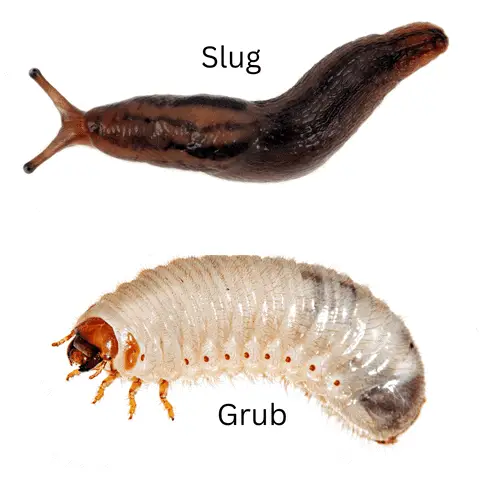As a gardener, you know that one of the most severe threats to your beautiful vegetable garden or lawn is represented by the presence of grubs and slugs. These two feared pests can damage our crop in a very short time, or permanently ruin the appearance of our beautiful lawn.
Unfortunately, slugs and grubs are not a rare sight, they are actually among the most common pests that can infest our gardens and lawns. Sometimes the damage they do is similar in appearance and can confuse us, so let’s analyze each one of these critters and see how you can prevent an infestation by these two dangerous pests.
What’s The Difference Between Slugs And Grubs?
Although both critters have an elongated and vermiform shape, they belong to two different species.
Slugs are terrestrial gastropod mollusks that hide underground during the day and emerge to feed by night, while grubs are larvae from the beetle family and live and develop underground.
The damage caused by slugs and grubs can have devastating consequences for our crops and lawns.
Let’s get to know more about them, so we can prevent an infestation by these critters.
What are Slugs?
In simple words, slugs are snails with no shells. They belong to the same family and their length ranges from 1 to 3 inches long. their color varies from gray to brown.
Slugs thrive in moist conditions. They just love seasons such as autumn and spring. In some areas they can be found at any time of the year, it essentially depends on the climate in that specific area.
Slugs are mainly nocturnal animals. They hide underground during the day to shelter from the heat and the sun. They come out in the evening when the temperatures drop and with them the humidity present in the air. It is not uncommon to find them in the middle of our journey even during the day, especially if it has rained.
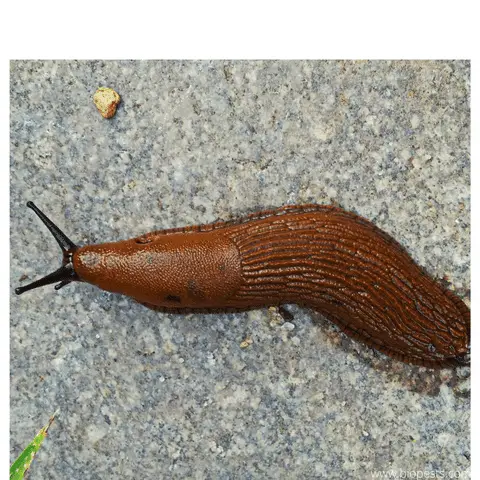
Once they emerge from the ground, slugs begin to search for food. They act as scavengers and would eat anything: from roots and leaves to dead animals and excrement. As they pass, they leave a trail of devastation (not to mention their unmistakable silver slime trail).
Are Slugs Bad For The Garden?
Slugs cause such damage that they are considered a real nightmare for lawn owners and farmers.
Don’t be fooled by their clumsy appearance! Although they move slowly and have the shape of a worm, slugs are capable of ruining an entire vegetable crop in a matter of hours, especially if the plants you grow are still sprouting.
Slugs especially love vegetables such as salad, spinach, cauliflower, broccoli, cabbage, basil, chard, and many more. Let’s be honest: slugs won’t say no to almost anything.
Do Slugs Live In The Lawn?
Lawns represent a great source of food and moisture, and it is no coincidence that they are slugs’ favorite places. Crawling on wet grass in the evening is extremely attractive for slugs.
During the day they like to hide from the heat and the sun and they rest in cool dark and dump places. These can be under rocks or underground.
They need to keep themselves moist all the time, if they don’t find a hiding place nearby, they would dig underground and rest there, covered by their own protective slime.
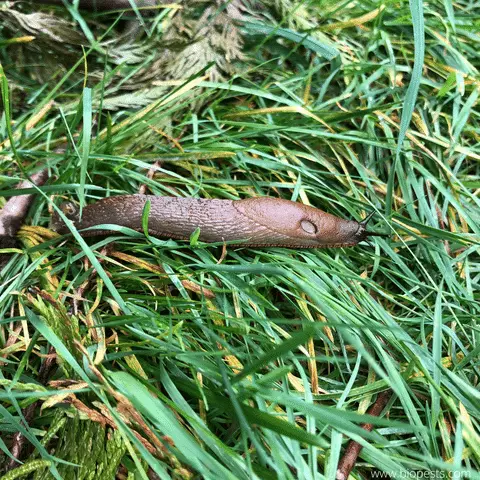
Slugs can dig underground, up to six feet deep! That’s the main reason why it is so difficult to find them during the day.
Slugs are active and feed at night. As I said before, slugs will eat anything, from grassroots to seedlings, and all the small animals that come in between.
How Do You Tell If You Have Slugs? What Does Slug Damage Looks Like?
It is quite simple to identify slug damage. These are the signs that your garden or lawn has been visited by slugs during the night:
- Irregular holes on the leaves of your plants.
- Fresh bite marks on leaves
- Their unmistakable silver slime trail
- Bare stems, where only the day before there was a seedling
- Black droppings on leaves (slugs release their droppings and eggs on the leaves of our plants)
- Eaten roots
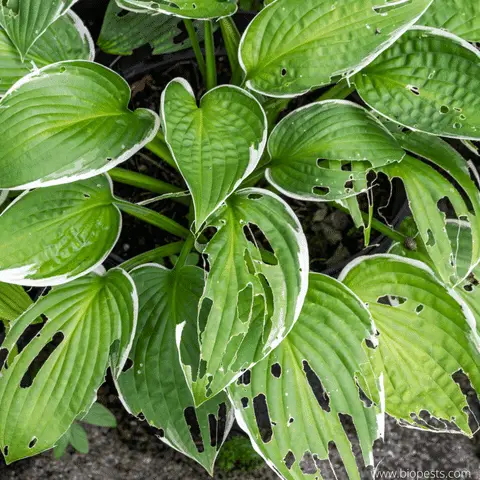
Why Do I Have Slugs In My Yard? What Attracts Them?
Two main factors attract slugs to your garden: food and shelter.
In particular, things that attract slugs are:
- Moisture (wet grass and wet soil)
- Wooden logs, rocks, and tall grass. All these represent a nice hiding spot where slugs can take shelter underneath during the day.
- A beautiful well-kept garden, full of all kinds of vegetables. Slugs are voracious eaters and love nutrient-dense plants.
How To Kill Slugs Naturally
Let’s start by saying that if feel compelled to dispel the myths I see online and tell you what “does not work” to get rid of these pesky pests.
Among the “organic” methods that I read about on various gardening sites, I hear a lot about basil and coffee grounds which supposedly should have repellent properties.
Unfortunately, from personal experience, I can assure you that they don’t work. Slugs seem attracted by basil seedlings, and as per the coffee grounds, I have noticed slugs crawling over them as if nothing had happened! Don’t get me started with the eggshells… All these methods have proved useless in repelling slugs, so I count them as “not working”.
These are the most effective methods to get rid of slugs:
- Apply some Diatomaceous Earth at the base of your plants. You can read this article to know more about DE and how to apply it.
- Apply some beneficial nematodes to the soil. These microscopic roundworms are a great way to control the slug population. Nematodes work by entering the slug bodies through their openings, eventually killing them. You can read more about beneficial nematodes here.
- Make some beer traps. Slugs are attracted to the beer that will lure them into the trap and drown them. Creating a trap is very simple. Just bury a jar leaving the opening at ground level. Fill it halfway with beer (a cheap one!). The next day all you have to do is collect the jar and count the victims.
Now that we have covered all there is to know about slugs, let’s find out what grubs are and how to prevent the damage associated with them.
What are grubs?
Grubs are insect larvae that belong to the beetle family.
Not all grubs are harmful to our lawns and gardens. The grubs that cause damage are usually Melolontha melolontha beetle larvae, a genus of beetles in the family Scarabaeidae. It is quite easy to identify them: they are white and rather large (40 mm- 1.5 inches) with a characteristic “C” shape, with 3 pairs of small, well-developed legs on the front area, near the head.
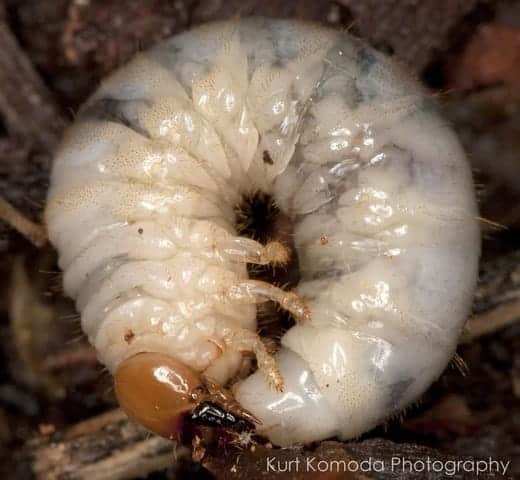
These grubs have one of the longest life cycles known! This is one of the factors that makes them so difficult to eradicate.
Their life cycle is normally completed in 3-4 years, during which most of the time is spent a few inches underground, where the larvae feed on the grassroots.
The grubs are potentially very dangerous for our gardens and lawns because they feed on the roots of our plants, causing their death.
This picture shows the characteristic patches of yellowed grass, typical damage created by grubs.
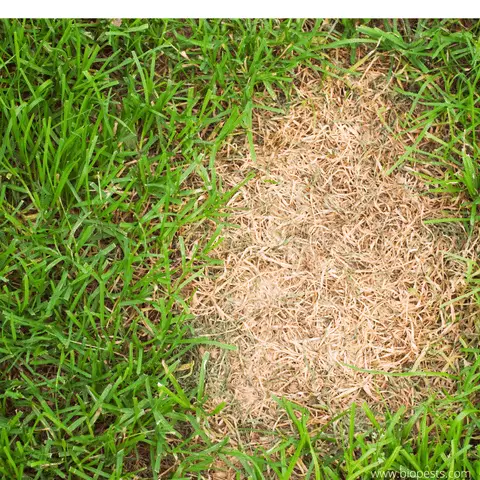
Are Grubs Bad For My Garden?
Grubs from the Melolontha melolontha family can cause serious damage to your garden and lawn.
They feed on roots, undermining the plant’s stability and ability to absorb the nutrients it needs from the soil, causing its death.
Even adult specimens are dangerous and spare no one. They feed on the leaves of plants and trees, causing severe defoliation.
Do Grubs Live In The Lawn?
Turf is the ideal place for grubs’ life cycle. Here they can feed abundantly, develop and overwinter.
Each female beetle lays about 50 eggs in the soil. which hatch after 40-60 days. After this time, the larvae begin to sneak into the soil. Turf provides protection and plenty of food, as the grubs go deep into the ground and overwinter.
How To Kill Grubs Naturally
Here are some natural methods to prevent a grub infestation:
- Where possible, frequently till the soil. This will prevent the soil from compacting and hardening too much and is a good way to notice the larvae in time and stop them from spreading. Once the soil has been dug, you can manually remove the grubs (or expose them to the cold temperature: they won’t resist the cold). This operation should preferably be done in November when you are sure that the eggs have hatched and that the larvae are visible.
- Remember to fertilize the soil in the spring. It seems that adult specimens are less attracted to mature manure and it will discourage them from laying their eggs.
- Apply beneficial nematodes in the soil. The application of beneficial nematodes is perhaps one of the most effective methods for eliminating grubs. To know how to apply beneficial nematodes you can read this article here.
If the infestation that has hit your garden or lawn is of serious proportions, you can opt to use chemical products, although I always advise against them for the vegetable garden.
In these cases, there are granular pesticides to mix with the soil or to spray on the leaves and tops of the plants.
Fun Facts About Grubs
Perhaps not everyone knows that grubs and beetles were eaten in the past! In 1821, the historian William Westermann reports that beetles and grubs were eaten by people from different areas in Europe. In fact, the peasants of the countryside used to capture the beetles to suck their entrails. They must have been particularly tasty because once upon a time the fortifying consumption of beetle broth was prescribed for convalescents!
Conclusion
We have seen that both of these two critters, the slugs, and the grubs, can cause great damage to our crops and lawns. in case of a minor infestation, it is possible to apply the natural methods mentioned above. If, on the other hand, it is a very extensive infestation, then it would be better to rely on a chemical treatment done by an expert.
Some of the links above are affiliate links, meaning I will earn a commission if you click through and make a purchase at no additional cost to you.

